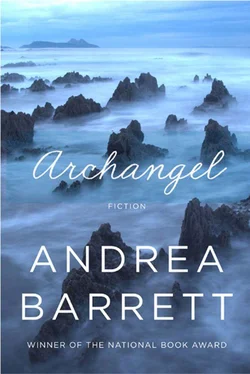Although they exchanged addresses, Henrietta left the island worrying that Daphne’s promise had been only politeness. A week after the end of the course, though, the first fat envelope arrived in Hammondsport: ten pages about the tent caterpillar infesting apple trees, complete with Daphne’s drawing of a web filled with writhing worms, diligently spinning their common tent before marching out to eat leaves. Henrietta sent back her comments, along with questions about something she’d read, and after that drawings, hypotheses, speculations, and books moved steadily between them. What, Henrietta wondered, would the professor make of this? She retained not his ideas but an image of his shining, enthusiastic face. Of his cane, which he’d held like a trident; of his wife’s steady gaze, welcoming as they’d made beds together; guarded — had she known what would happen? — as Henrietta reached for the Cyanea .
Her mother, so upset when Henrietta returned home early, and so disbelieving when Henrietta explained how her views had changed, at her urging read Mr. Darwin’s book, which had been in the village library all along. When she finished she read it again; then, troubled but not convinced, she began to argue with Henrietta. Hester sat between them at the dining room table, beneath the professor’s signed letter, listening to both of them. A deep furrow, Henrietta was pained to see, sometimes appeared between Hester’s eyebrows, as if the two sets of ideas were pulling her brain apart. Then Hester would say that her head hurt, and their mother would frown at Henrietta and declare their discussions closed for the day.
On those nights Henrietta went to bed feeling even more lonely than she had during her first days on the island. She reminded herself, and her mother, too, that she was far from discarding all that she had learned from the professor. At her new job, she used his methods — few books, many specimens, constant close observation — to teach Mr. Darwin’s theories. And at least once a week, as he would have recommended, she gathered her students for expeditions outside.
In December, she took them to the Glen at the edge of the village, where the waterfall had frozen. Dormant ferns dotted the shale cliffs, which were layered with fossils; the fields rippled with glacial moraines and she could not, she thought, have found a better place to demonstrate the workings of time. They picked their way along the icy rocks, some of the students searching for weathered-out brachiopods while others attacked the gorge wall with chisels. Some collected lichens and frozen mosses and ferns, some inspected the swallows’ nests, some looked for tracks in the light snow. She found a frozen mole carcass, which she brought home for Hester.
That night her mother, after admiring the mole, sat her down at the table and passed her a plate of stew with dumplings. There was a folded newspaper near Henrietta’s spoon. She glanced at the front page and then looked again and unfolded it and read. The professor had died unexpectedly, she learned, after eating a heavy meal and smoking a forbidden cigar. The article, which filled an entire page, included remarks by many of his students, among them several who’d taught her at the island. No one mentioned disagreements with Mr. Darwin. They concentrated, instead, on his great enthusiasm for natural history, which had never waned, and on his ability to inspire students of all ages and backgrounds. One woman wrote fondly of a class she’d taken years ago, when she was young herself, during which he’d pressed a living grasshopper into each of their hands. They were supposed to follow his lead as he lectured, inspecting a leg joint or a wing, but the grasshoppers kept escaping and popping into the air. What the woman remembered most was the way the professor had laughed and stopped his lecture each time, waiting for them to recapture the runaways.
That was one side, which Henrietta cherished. The other was apparent in the poem Whittier offered, memorializing the professor’s last project. Of the endless stanzas, too many to finish, she read these:
On the isle of Penikese,
Ringed about by sapphire seas,
Fanned by breezes salt and cool,
Stood the Master with his school .
Over sails that not in vain
Wooed the west-wind’s steady strain,
Line of coast that low and far
Stretched its undulating bar,
Wings aslant along the rim
Of the waves they stooped to skim,
Rock and isle and glistening bay,
Fell the beautiful white day .
Said the Master to the youth:
“We have come in search of truth,
Trying with uncertain key
Door by door of mystery;
We are reaching, through His laws,
To the garment-hem of Cause,
Him, the endless, unbegun,
The Unnameable, the One
Light of all our light the Source,
Life of life, and Force of force .
As with fingers of the blind,
We are groping here to find
What the hieroglyphics mean
Of the Unseen in the seen,
What the Thought which underlies
Nature’s masking and disguise,
What it is that hides beneath
Blight and bloom and birth and death.”
Blight and bloom and birth and death, Nature’s mask — there was no mask, no underlying thought, only life itself. Behind the garment-hem of Cause, the real skirt she’d torn and stained. In place of sapphire seas, the real, gray, salty ocean, ringing the island — not an isle — where she and Daphne had met.
“I’m sorry,” her mother said quietly.
A little black cricket, Henrietta remembered, had leapt into the air that first day at the island, as if presenting itself for the professor’s inspection and delight. “I am too,” she said.
Once he was in the water, it was easier to see what had happened to the ship. The stern already low in the waves, the empty lifeboat davits and twisted rigging and the blackened, shattered wood on the deck, where the exploding hatches had blown deck chairs and people to bits. They’d been at dinner, spoons clicking on soup bowls, cooks poised over pots, Sam Cornelius thrown from his chair as he pushed aside a bit of carrot. Now it was past nine and fully dark. The searchlight picked out bodies floating near the boat, and when the woman crouched behind him gave her life belt to her wailing son, Sam gave her his and then was even more frightened; despite his age — he was thirty-four — he could barely swim.
In the distance a shape, which might have been the guilty submarine, seemed to shift position. The moon disappeared behind a bank of clouds and then it rained, drenching those who weren’t yet soaked; more than eleven hundred people had been on board. When the rain stopped, the moon again lit the boats scattered around the slowly sinking ship. The three of the Athenia ’s crew in Sam’s boat took oars, as did the three least wounded — Sam was one — of the four male passengers. The others, just over fifty women and children, bailed with their shoes and their bare hands, scooping out the oily water rising over their shins.
As the two dozen lifeboats separated like specks on an expanding balloon, one pulled toward Sam’s boat to let them know that several ships had responded to the Athenia ’s call for help. Soon, in just a few hours, they’d be saved. Those hours passed. Not long after midnight, a faraway gleam, which might have been a periscope caught by the light of the moon, caused two women to shriek. A U-boat, one said, the German submarine that had torpedoed them rising now to shell the lifeboats. But the last beam of the searchlight, just before the emergency dynamo used up its fuel and the Athenia went completely dark, revealed enough to convince Sam and some of the others that this was a rescue ship.
Читать дальше












